QuickLinks:
100, 101, 102, 103, 104, 105, 106, 107, 108, 109, 110, 111, 112, 113, 114, 115, 116,
117, 118, 119, 120, 121, 122, 123, 124, 125, 126, 127, 128, 129, 130, 131, 132, 133,
134, 135, 136, 137, 138, 139, 140, 141, 142, 143, 144, 145, 146, 147, 148, 149
Page last updated Aug 9, 2021
Checked updated Corwin positions
Partially updated formatting and images to current standards
(Several years ago) Checked historical references, Dreyer IC entries
IC 100 (= PGC 5029)
Discovered (Dec 14, 1892) by Stephane Javelle
A 14th magnitude spiral galaxy (type SAB0) in Cetus (RA 01 22 54.0, Dec -04 38 35)
Historical Identification: Per Dreyer, IC 100 (Javelle 522, 1860 RA 01 15 49, NPD 95 22.5) is "faint, very small, round, nucleus equal to 12.5 magnitude star". The position precesses to within 0.1 arcmin of the correct position, so the identification is certain. Based on recessional velocity of 5255 km/sec, about 230 million light years distant. Given that and apparent size of 1.1 by 0.8 arcmins, about 75 thousand light years in diameter.

Above, a 12 arcmin wide DSS image centered on IC 100, also showing PGC 1056754
Below, a 1.2 arcmin wide DSS image of the galaxy

IC 101
(= PGC 5147 = UGC 949 = CGCG 436-039 = MCG +02-04-036)
Discovered (Dec 2, 1893) by Stephane Javelle
A magnitude 14.0 spiral galaxy (type SA(s)a) in Pisces (RA 01 24 08.6, Dec +09 55 49)
Historical Identification: Per Dreyer, IC 101 (Javelle 523, 1860 RA 01 16 47, NPD 80 47.6) is "very faint, pretty large, extended, diffuse." The position precesses to RA 01 24 08.1, Dec +09 56 19, less than 0.5 arcmin north-northwest of the galaxy listed above, the description fits and there is nothing comparable nearby, so the identification is certain.
Physical Information: Based on a recessional velocity relative to the Cosmic Microwave Background radiation of 2090 km/sec (and H0 = 70 km/sec/Mpc), IC 101 is about 95 to 100 million light-years away, in fair agreement with redshift-independent distance estimates of about 110 to 145 million light-years. Given that and its apparent size of about 1.0 by 0.45 arcmin (from the images below), the galaxy is about 25 to 30 thousand light-years across.
Note About Classification: The type is taken from the Spitzer Survey of Stellar Structure in Galaxies. The range of visible-light classifications overlaps the Spitzer Survey classification, so I have left it as-is.
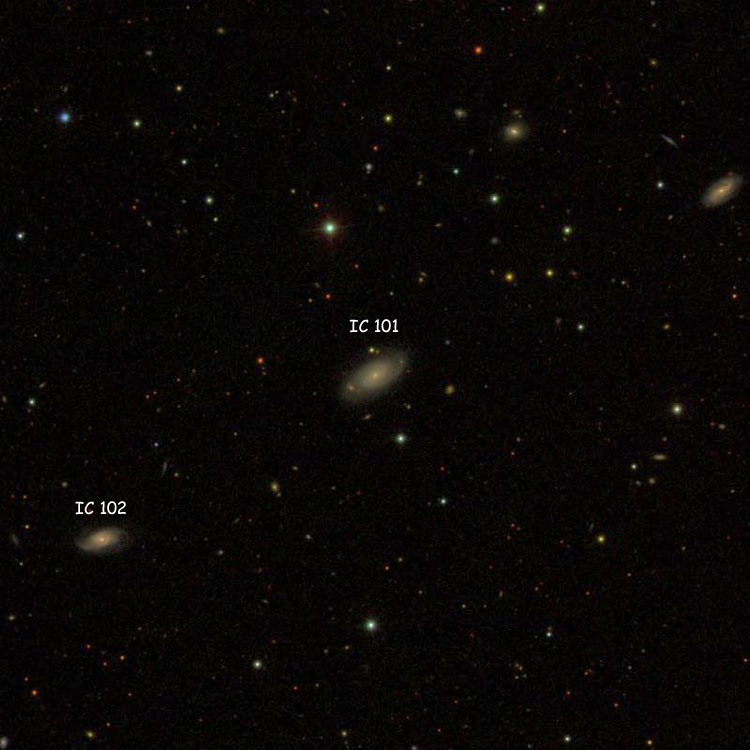
Above, a 12 arcmin wide SDSS image centered on IC 101, also showing IC 102
Below, a 1.2 arcmin wide SDSS image of the galaxy

IC 102 (= PGC 5172)
Discovered (Dec 2, 1893) by Stephane Javelle
A 15th magnitude spiral galaxy (type S0/a) in Pisces (RA 01 24 26.3, Dec +09 53 12)
Historical Identification: Per Dreyer, IC 102 (Javelle 524, 1860 RA 01 17 04, NPD 80 50.2) is "extremely faint, small, diffuse". Like IC 101, which was discovered on the same night, the position precesses to 0.5 arcmin north of the correct position, and the identification is certain.
Physical Information: *NEED TO USE RELATIVISTIC 3K Vr* Based on recessional velocity of 14420 km/sec, about 640 million light years away. Given that and apparent size of 0.9 by 0.3 arcmin, about 170 thousand light years across.
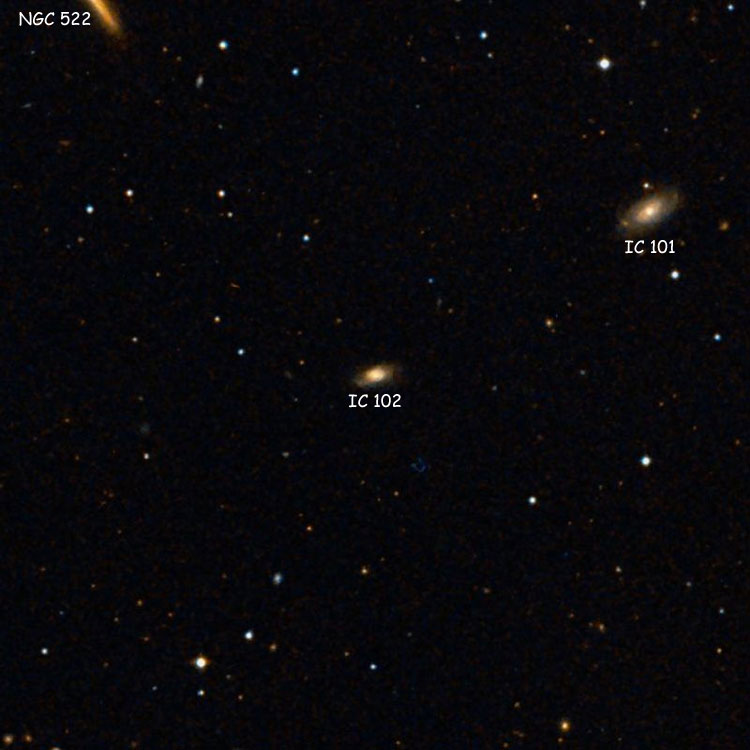
Above, a 12 arcmin wide DSS image centered on IC 102, also showing IC 101
Below, a 1 arcmin wide DSS image of the galaxy

IC 103 (= PGC 5192)
Discovered (Nov 5, 1891) by Stephane Javelle
A 14th magnitude lenticular galaxy (type E/S0?) in Cetus (RA 01 24 36.4, Dec +02 02 39)
Historical Identification: Per Dreyer, IC 103 (Javelle 53, 1860 RA 01 17 21, NPD 88 40.7) is "faint, very small, round". The position precesses to 0.9 arcmin northwest of the correct position, but there is nothing else in the area, so the identification is certain.
Physical Information: *NEED TO USE RELATIVISTIC 3K Vr* Based on recessional velocity of 9600 km/sec, about 430 million light years away. Given that and apparent size of 0.9 by 0.5 arcmin, about 110 thousand light years across.

Above, a 12 arcmin wide DSS image centered on IC 103, also showing IC 105
Below, a 1 arcmin wide DSS image of the galaxy

PGC 94065
Not an IC object but listed here as an apparent companion of IC 103
A magnitude 15.5(?) galaxy (type S0/a?) in Cetus (RA 01 24 32.9, Dec +02 00 08)
Physical Information:
IC 104
Recorded (Nov 16, 1887) by Guillaume Bigourdan
A 13th magnitude double star in Cetus (RA 01 24 33.5, Dec -01 27 21)
Per Dreyer, IC 104 (Bigourdan 118, 1860 RA 01 17 25, NPD 92 11) is "stellar, 13th magnitude". The position precesses to within 0.3 arcmin of a 13th magnitude double star, so although Bigourdan's description was more accurate than his presumption of some nebulosity, the identification is certain.
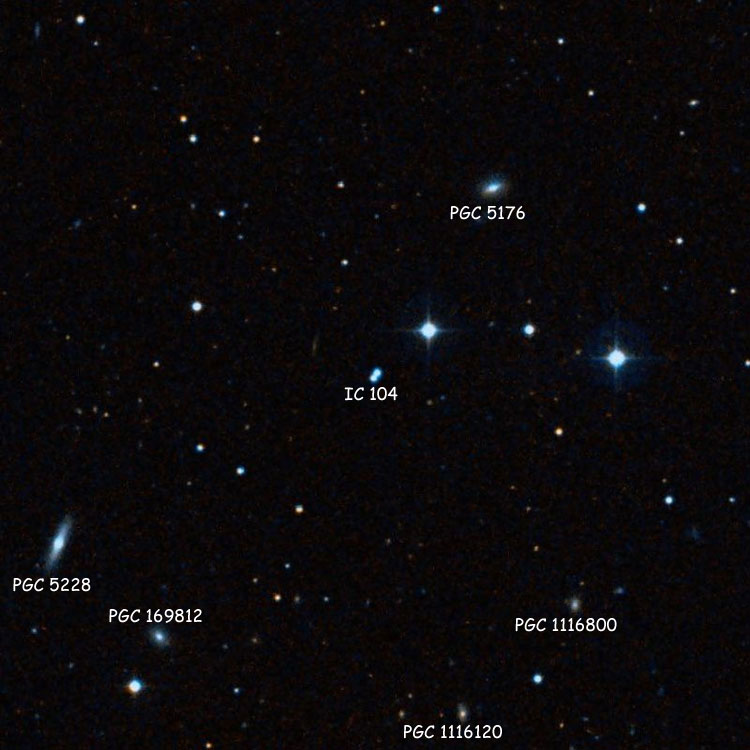
Above, a 12 arcmin wide region centered on IC 104
IC 105 (= PGC 5206)
Discovered (Nov 5, 1891) by Stephane Javelle
A 15th magnitude galaxy (type S?) in Cetus (RA 01 24 46.3, Dec +02 04 31)
Per Dreyer, IC 105 (Javelle 54, 1860 RA 01 17 30, NPD 88 38.8) is "faint, extremely small, round, a little brighter middle". The position precesses to 1.2 arcmin northwest of the correct position. Javelle had a similar error for IC 103, which he observed the same night, so as in that case, the current identification seems reasonably certain. Based on recessional velocity of 9765 km/sec, about 435 million light years away. Given that and apparent size of 0.55 by 0.25 arcmin, about 65 thousand light years across. 
Above, a 12 arcmin wide DSS image centered on IC 105, also showing IC 103
Below, a 1 arcmin wide DSS image of the galaxy

PGC 1214617
Not an IC object but listed here as a possible companion of IC 105
A magnitude 16(?) galaxy (type ?) in Cetus (RA 01 24 54.1, Dec +02 03 25)
Physical Information: LEDA B 16.7, I 14.6; NED mag 17.3(?), .35 x .22 arcmin, 3K Vr 8905 km/sec, z 0.029704273388
IC 106 (= NGC 530 = PGC 5210 = PGC 73947)
Discovered (Nov 20, 1886) by Lewis Swift (and later listed as NGC 530)
Discovered (Nov 16, 1887) by Guillaume Bigourdan (and later listed as IC 106)
A 13th magnitude lenticular galaxy (type S0/a?) in Cetus (RA 01 24 41.7, Dec -01 35 14)
Per Dreyer, IC 106 (Bigourdan 119, 1860 RA 01 17 33, NPD 92 19) is "very faint, small, diffuse, a little brighter middle". The position precesses to within 0.3 arcmin of the correct position, so the identification with PGC 5210 is certain. Per Corwin and Thomson, Bigourdan thought this a new object because of a 15 second error in Swift's RA. When Bigourdan revisited the area in 1897, he recorded a nearly identical position for NGC 530, which should have made its identity with IC 106 obvious, and in any case, Howe noted the identity the following year. So although the IC listing was not removed, its identification with NGC 530 was realized early on, and included in Dreyer's IC2 corrections.
IC 107 (= IC 1700)
(= PGC 5271 = UGC 986 = CGCG 436-047 = MCG +02-04-041)
Discovered (Sep 18, 1890) by Lewis Swift (and later listed as IC 107)
Discovered (1896) by Stephane Javelle (and later listed as IC 1700)
A magnitude 12.9 lenticular galaxy (type (R')SA(r)0- pec (PRG?)) in Pisces (RA 01 25 24.7, Dec +14 51 53)
Historical Identification: Per Dreyer, IC 107 (Swift list X (# 5), 1860 RA 01 17 38, NPD 75 51.2) is "very faint, very small, round, star close to the west". The position precesses to RA 01 25 05.1, Dec +14 52 39, about 20 seconds of time west and 0.8 arcmin north of the galaxy listed above and considerably closer to PGC 5250, which has led to nearly universal misidentification of that galaxy as IC 107, even though it is the faintest of the three galaxies in the region. However, as stated by Corwin, "close star to the west" must refer to the (magnitude 14) star southwest of PGC 5271 (which is also listed as IC 1700, because when Javelle observed the region, the 20 second error in Swift's right ascension made Javelle assume that he had found a new nebula). In addition, as noted by Corwin and several colleagues involved in correcting historical errors in modern catalogues, it is inconceivable that using his wide-field eyepiece, Swift could have seen the faintest of the three galaxies in the region and not seen either of the brighter ones, and the 20 second error in the right ascension is typical of Swift's errors in right ascension, so the identification of PGC 5271 as IC 107 and as an earlier observation of what is also called IC 1700 is now considered certain.
"Search" Note: Due to the relatively recent realization that IC 107 is a duplicate observation of IC 1700, many references still incorrectly list PGC 5250 as IC 107, so the PGC number or coordinates for PGC 5271 should be used in any search for IC 107.
Physical Information: As it happens, IC 107 is almost certainly a physical companion of PGC 5250, the object formerly identified as IC 107, and of IC 1698, so the distance of the "group" should probably be based on an average of their recessional velocities relative to the Cosmic Microwave Background, which for IC 107 is 6045 km/sec, for PGC 5250 is 6055 km/sec, and for IC 1698 is 6245 km/sec. The average of those values is about 6115 km/sec. Based on that (and H0 = 70 km/sec/Mpc), the group is about 280 to 285 million light-years away, somewhat further than redshift-independent distance estimates of about 195 to 245 million light-years, but given the wide range of those estimates, not sufficiently further to be concerned about the difference. Given that and its apparent size of about 1.2 by 0.9 arcmin for the bright inner galaxy (as shown in the closeup image) and about 1.7 by 1.3 arcmin for the fainter outer region (in the wide-field image), IC 107 is about 100 thousand light-years across, and its outer regions span about 140 thousand light-years.
Classification Note: IC 107 is usually listed as an elliptical galaxy, but the wide-field image below seems to show a somewhat distorted extended region (apparently a partial outer ring) surrounding the galaxy, and the closeup image shows an exceptionally bright nucleus, and signs of an inner ring and some kind of horizontal structure (perhaps an inner polar ring) between the nucleus and the aforementioned outer ring; hence the "type" shown in the description line above. (Thanks to Harold Corwin for confirming and slightly altering my educated guess.)

Above, a 12 arcmin wide SDSS image centered on IC 107, also showing PGC 5250, IC 1698, and Swift's position
(The "bright" star at right is the magnitude 10.0 variable star BD+14 215)
Below, a 1.5 arcmin wide SDSS image of PGC 5271 (= IC 107) (Post-processing of both images by Courtney Seligman)

PGC 5250 (not = IC 107)
(= UGC 978 = CGCG 436-044 = MCG +02-04-039)
NOT an IC object but listed here because almost universally misidentified as IC 107
AND as a probable physical companion of the actual IC 107
A magnitude 15(?) spiral galaxy (type SAB(s)c II:) in Pisces (RA 01 25 13.3, Dec +14 52 21)
Historical (Mis)Identification: As noted in the entry for IC 107, PGC 5250 lies between that galaxy and Swift's position for what became IC 107, and as a result, PGC 5250 was long misidentified as the IC object; however, for the reasons discussed there, IC 107 must actually be an early observation of what was later rediscovered as IC 1700, and PGC 5250, which is the faintest of the three galaxies in the region, cannot possibly be IC 107. However, as noted in the next paragraph, it turns out that all three galaxies are almost certainly a physical group, so PGC 5250 is "related" to IC 107; it just isn't the actual galaxy that should be designated by that entry.
Physical Information: Given their close position in the sky and as it turns out, very similar recessional velocities, PGC 5250, IC 107, and IC 1698 are almost certainly physical companions, so their distances are best determined by using an average of recessional velocities relative to the Cosmic Microwave Background. The calculations involved are shown in the entry for IC 107, and place the group about 280 to 285 million light-years from us. Given that and its apparent size of about 0.9 by 0.7 arcmin (from the images below), PGC 5250 is about 75 thousand light-years across.
Classification Note: Corwin points out that there may be a hint of a short bar, but the galaxy is mostly non-barred, hence the underlined "A". He also suggests luminosity class II:, with the colon indicating that the luminosity class is uncertain since the galaxy is so faint; but quotes van den Bergh as saying "The more luminous a galaxy is, the prettier it is!" (or words to that effect), and since this is a "pretty" spiral, he feels class II is more likely than III.
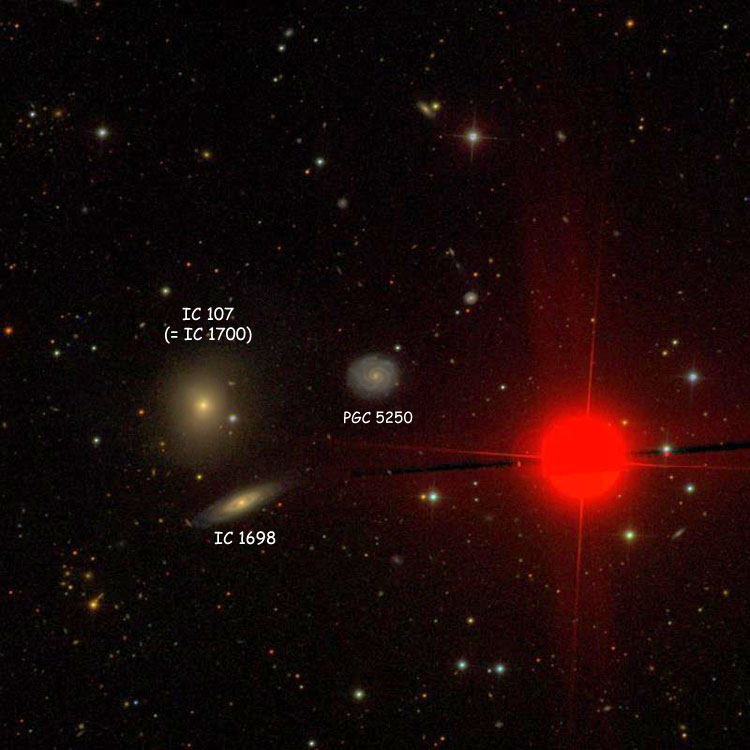
Above, a 12 arcmin wide SDSS image centered on PGC 5250, also showing IC 107 and 1698
(The "bright" star at right is the magnitude 10.0 variable star BD+14 215)
Below, a 1 arcmin wide SDSS image of PGC 5250 (Post-processing above and below by Courtney Seligman)

*PanSTARRS images now available*
IC 108 (= PGC 5205)
Discovered (Nov 3, 1891) by Stephane Javelle
A 14th magnitude spiral galaxy (type Sa? pec) in Cetus (RA 01 24 39.0, Dec -12 38 08)
Per Dreyer, IC 108 (Javelle 55, 1860 RA 01 17 44, NPD 103 21.9) is "faint, pretty large, extended north-south". The position precesses to within 0.1 arcmin of the correct position, so the identification is certain. Based on recessional velocity of 15745 km/sec, about 700 million light years away. Given that and apparent size of 1.3 by 0.35 arcmin, about 260 thousand light years across.
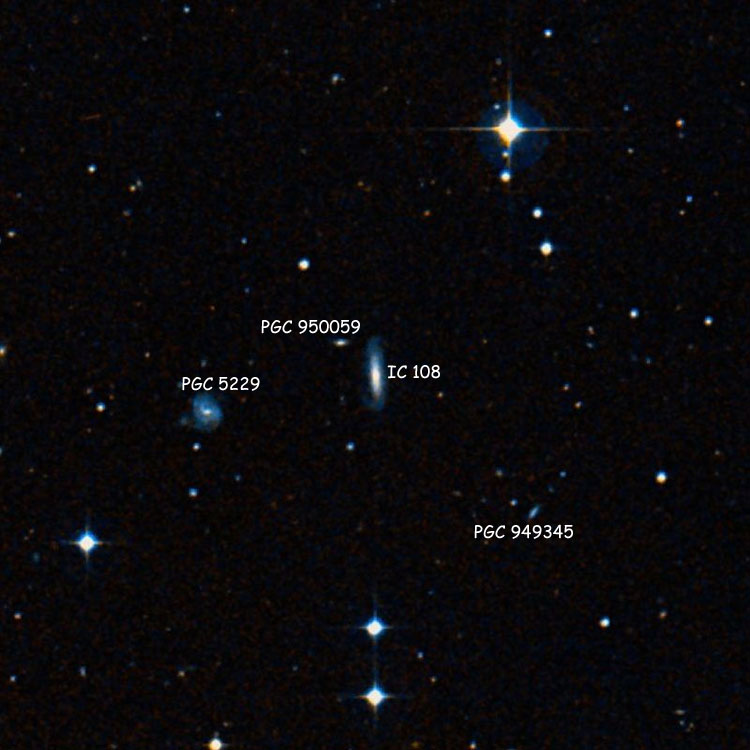
Above, a 12 arcmin wide DSS image centered on IC 108, also showing PGC 5229
Below, a 1.5 arcmin wide DSS image of IC 108 (and PGC 950059)
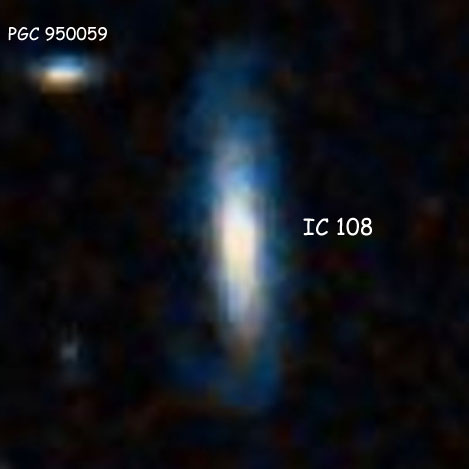
PGC 5229
(= MCG -02-04-043)
Not an IC object but listed here as an apparent companion of IC 108
A magnitude 15.5(?) spiral galaxy (type SAB(s)bc?) in Cetus (RA 01 24 50.1, Dec -12 38 43)
Physical Information (with a Vr over 1000 km/sec less than IC 108, probably a foreground object and not an actual companion)
LEDA B 16.3, I 14.5, SBR; NED .5 x .4 arcmin, 3K Vr 14295 km/sec, z 0.047683321678
*PanSTARRS images now available*
IC 109 (= PGC 5251)
Discovered (Nov 5, 1891) by Stephane Javelle
A 14th magnitude lenticular galaxy (type (R)SB(r)0) in Cetus (RA 01 25 13.0, Dec +02 04 01)
Per Dreyer, IC 109 (Javelle 56, 1860 RA 01 17 57, NPD 88 39.2) is "pretty bright, very small, round". Like IC 103 and 105, which Javelle observed on the same night, the position precesses to 1.2 arcmin northwest of the correct position, and despite the measurement error, the identification seems reasonably certain. Based on recessional velocity of 9750 km/sec, about 435 million light years away. Given that and apparent size of 0.9 by 0.65 arcmin, about 120 thousand light years across.
Note About Apparent Companion: It has been suggested that PGC 212757, a roughly magnitude 16.5 to 17 spiral galaxy to the south of IC 109 (RA 01 25 12.8, Dec +02 02 25), might be a companion of the IC object; however, other than what can be determined from the images below (namely, its apparent size), no information about it appears to be available, so whether it is a companion, a foreground object, or a background object cannot be known. 
Above, a 12 arcmin wide DSS image centered on IC 109, also showing PGC 212757 and several other PGC galaxies
Below, a 1 arcmin wide DSS image of the galaxy

IC 110
Recorded (Nov 5, 1885) by Guillaume Bigourdan
A "lost" or nonexistent object in Pisces (RA 01 25 56, Dec +33 29 49)
Corwin lists a possible identification as a double star at (RA 01 25 49.,7, Dec +33 31 16)
Per Dreyer, IC 110 (Bigourdan 120, 1860 RA 01 18 03, NPD 57 14) is "very faint". The position precesses to the value listed above, as shown by the "+" in the image below, but there is nothing Bigourdan is likely to have been able to see at or near this location (the nearby galaxy is 16th magnitude, and the stars are all 15th magnitude or fainter). Per Corwin, the position of IC 110 was measured relative to IC 111 (which see for an image of the region near IC 110), which either does not exist, or was badly mis-measured; so in the unlikely event that IC 110 refers to a real object, the chances of identifying it are nil. Note: Steinicke, Corwin and Thomson list positions ranging from RA 01 25 46 to 01 25 50, and Dec +33 30 40 to +33 31 16, which are near the right side of the image below; however, that region is even emptier, so although the reason for the different positions is unclear, it doesn't change the result.
*Corwin lists two positions by Bigourdan, and several positions for a possible (albeit unlikely) identification
IC 111
Recorded (Nov 5, 1885) by Guillaume Bigourdan
Apparently a lost or nonexistent object in Pisces (RA 01 25 58, Dec +33 28 49)
Per Dreyer, IC 111 (Bigourdan 121, 1860 RA 01 18 05, NPD 57 15) is "a 13th magnitude star with nebulosity". The position precesses to the value above, but there is nothing at or near that location. Per Corwin, Bigourdan's measurement of 1885 should be the IC position. Bigourdan recorded a different measurement in 1900, referring to a granular object which could be an asterism of six faint stars; but since that is two arcmin away from the original position, although it may be a valid observation, it is certainly not the IC 111 recorded by Dreyer, and probably not what Bigourdan saw (or not) in 1885.

Above, a 6 arcmin wide region centered on the supposed positions of IC 110 and 111
IC 112 (= PGC 5328)
Discovered (Dec 4, 1893) by Stephane Javelle
A 14th magnitude spiral galaxy (type Sdm?) in Pisces (RA 01 26 03.0, Dec +11 26 35)
Per Dreyer, IC 112 (Javelle 525, 1860 RA 01 18 39, NPD 79 16.7) is "faint, small, diffuse, extended east-west". The position precesses to only 0.5 arcmin north of the correct position, so the identification is certain. Based on recessional velocity of 5820 km/sec, about 260 million light years away. Given that and apparent size of 0.8 by 0.4 arcmin, about 60 thousand light years across.

Above, a 12 arcmin wide DSS image centered on IC 112
Below, a 1 arcmin wide DSS image of the galaxy
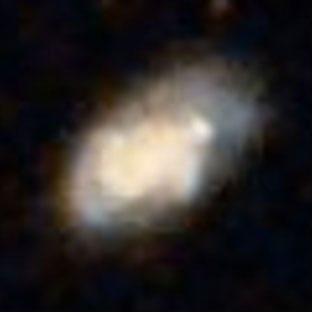
IC 113 (= 2MASX J01262551+1911308)
Discovered (Jul 25, 1890) by Sherburne Burnham
A 15th magnitude galaxy (type E0?) in Pisces (RA 01 26 25.5, Dec +19 11 31)
Historical Identification: Per Dreyer, IC 113 (Burnham, 1860 RA 01 18 52, NPD 71 32.2) is "very faint, 3 arcmin northeast of 5th magnitude star". The position precesses to within 0.2 arcmin of the correct position, and there is a 5th magnitude star (ρ Piscium) just under 3 arcmin southwest of the galaxy, so the identification is certain.
Note About Non-Standard Designation: Sometimes confusingly called IC 113B, which is not only a non-standard designation, but since there is no "IC 113A" makes no sense, and is a good example of why such non-standard letter designations should never be used except in warnings meant to discourage such use.
Physical Information: Apparent size about 0.25 by 0.25 arcmin (from the images below); nothing else seems to be available.

Above, a 12 arcmin wide DSS image centered on IC 113
Below, a 0.5 arcmin wide SDSS image of the galaxy
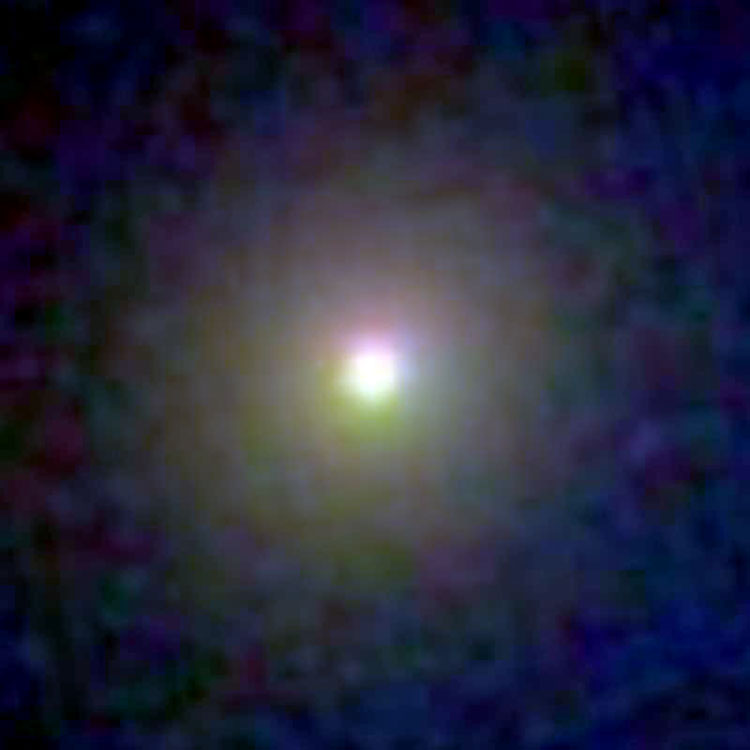
IC 114 (= PGC 5343)
Discovered (Dec 2, 1893) by Stephane Javelle
A 14th magnitude spiral galaxy (type S?) in Pisces (RA 01 26 22.6, Dec +09 54 36)
Per Dreyer, IC 114 (Javelle 526, 1860 RA 01 19 01, NPD 80 48.6) is "extremely faint, very small, round". The position precesses to 01 26 22, +09 55 10, which is within 0.6 arcmin of the correct position, so the identification is certain. Based on recessional velocity of 2275 km/sec, about 100 million light years away. Given that and apparent size of 1.5 by 0.6 arcmin, about 45 thousand light years across.

Above, a 12 arcmin wide DSS image centered on IC 114
Below, a 1.5 arcmin wide DSS image of the galaxy

*PanSTARRS images now available*
IC 115 (= PGC 5395)
Discovered (Jul 25, 1890) by Sherburne Burnham
A 14th magnitude elliptical galaxy (type E0?) in Pisces (RA 01 26 54.4, Dec +19 12 52)
Per Dreyer, IC 115 (Burnham, 1860 RA 01 19 21, NPD 71 30.8) is "very faint, 6th magnitude star 3 1/2 arcmin to west northwest". The position precesses to within 0.2 arcmin of the correct position, and there is a 6th magnitude star (94 Piscium) about 3 1/2 arcmin to the northwest, so the identification is certain. Based on recessional velocity of 12795 km/sec, about 570 million light years away. Given that and apparent size of 0.7 by 0.7 arcmin, about 115 thousand light years across.

Above, a 12 arcmin wide DSS image centered on IC 115
Below, a 1 arcmin wide DSS image of the galaxy
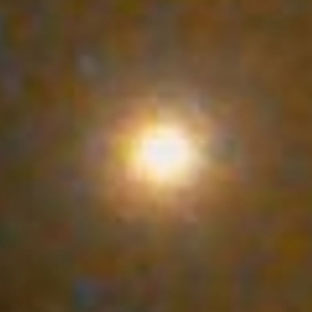
*PanSTARRS images now available*
IC 116 (= PGC 5389)
Discovered (Dec 14, 1892) by Stephane Javelle
A 14th magnitude spiral galaxy (type Sd) in Cetus (RA 01 26 50.6, Dec -04 58 57)
Per Dreyer, IC 116 (Javelle 57, 1860 RA 01 19 46, NPD 95 42.7) is "faint, small, round, a little brighter middle". The position precesses to within 0.3 arcmin of the correct position, so the identification is certain. Based on recessional velocity of 5485 km/sec, about 245 million light years away. Given that and apparent size of 0.9 by 0.5 arcmin, about 65 thousand light years across.

Above, a 12 arcmin wide DSS image centered on IC 116
Below, a 1 arcmin wide DSS image of the galaxy

*Need to read Corwin's notes again*
IC 117
Recorded (Nov 6, 1891) by Stephane Javelle
A lost or nonexistent object in Cetus (RA 01 27 22, Dec -01 51 49)
or possibly a magnitude 10.5 star at RA 01 27 25.7, Dec -01 51 40
Per Dreyer, IC 117 (Javelle 58, 1860 RA 01 20 14, NPD 92 35.5) is "pretty faint, small, diffuse, III 441 to southeast", (WH) III 441 being NGC 560. The position precesses to that shown above, but there is nothing there save an 11th magnitude star (which NED takes as IC 117), which does not fit the description "pretty faint", and is directly north of NGC 560, instead of to the northwest. Corwin makes a fairly convincing argument that IC 117 could be the same as NGC 560, if Javelle misidentified his comparison star (there is another one he is as likely to have used, which would have put his object exactly where NGC 560 lies). But if IC 117 was NGC 560, what of the object Javelle thought was NGC 560, to the southeast of his object? Since there is nothing there, Corwin's suggestion, though attractive, cannot be viewed as convincing. Similarly, Thomson suggests that what Javelle saw might have been NGC 558, then does a good job demolishing his own argument. The upshot is, there is no convincing argument which identifies IC 117 with any particular object. Steinicke therefore lists the object as "Not Found", and I agree with his assessment.
Note About Possible Companion: Presuming that IC 117 is NGC 560, Corwin lists an apparent companion at RA 01 27 16.2, Dec -01 58 15; but even if IC 117 is NGC 560, the appropriate place to discuss such a companion is at the entry for NGC 560, so no further mention of it will be made here. 
Above, a 12 arcmin wide DSS image centered on the supposed position of IC 117 (marked by a "+")
The star that might be IC 117 is also shown (albeit with a question mark)
*PanSTARRS images now available*
IC 118 (= PGC 5446)
Discovered (Dec 14, 1892) by Stephane Javelle
A 15th magnitude elliptical galaxy (type E0?) in Cetus (RA 01 27 36.0, Dec -04 59 51)
Per Dreyer, IC 118 (Javelle 527, 1860 RA 01 20 32, NPD 95 43.4) is "very faint, very small, round, a little brighter middle". The position precesses to within 0.1 arcmin of the correct position, so the identification is certain. Based on recessional velocity of 14110 km/sec, about 630 million light years away. Given that and apparent size of 0.6 by 0.5 arcmin, about 100 thousand light years across.

Above, a 12 arcmin wide DSS image centered on IC 118
Below, a 1 arcmin wide DSS image of the galaxy

*PanSTARRS image of galaxy is FAR better*
IC 119 (= PGC 5465)
Discovered (Nov 6, 1891) by Stephane Javelle
A 14th magnitude spiral galaxy (type SAB(r)c? pec) in Cetus (RA 01 27 55.0, Dec -02 02 26)
Per Dreyer, IC 119 (Javelle 59, 1860 RA 01 20 47, NPD 92 46.1) is "faint, extended east-west, diffuse, III 442 to north", (WH) III 442 being NGC 564. The position precesses to within 0.1 arcmin of the galaxy listed above, and NGC 564 is 10 arcmin to its north, so the identification is certain. Listed as part of Abell 194. Based on recessional velocity of 6025 km/sec, about 270 million light years away. Given that and apparent size of 1.3 by 0.6 arcmin, about 100 thousand light years across. 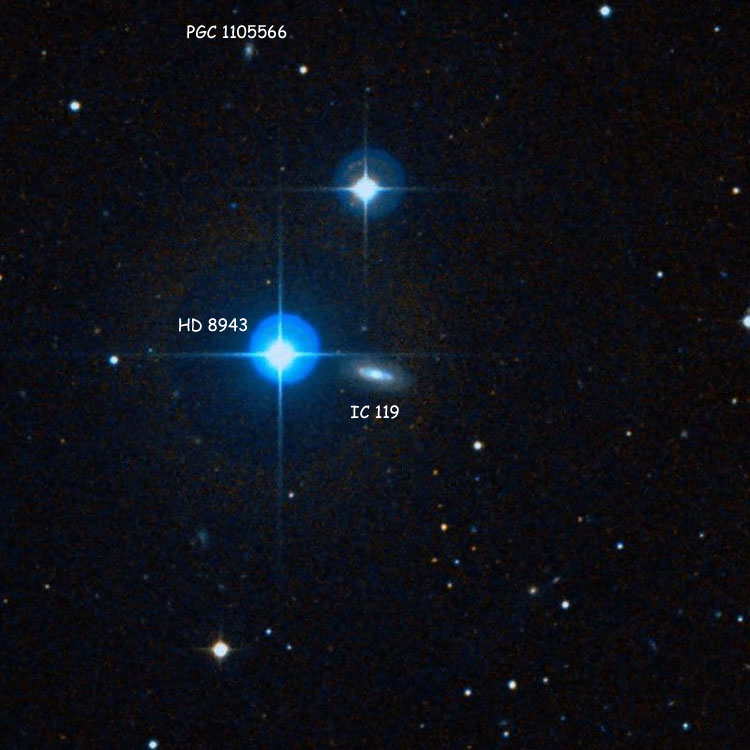
Above, a 12 arcmin wide DSS image centered on IC 119; the 7th magnitude star to the left (east) of the galaxy is HD 8943
Below, a 1.5 arcmin DSS image of the galaxy

Below, a 12 arcmin wide region centered between IC 119 and NGC 564, also showing IC 120
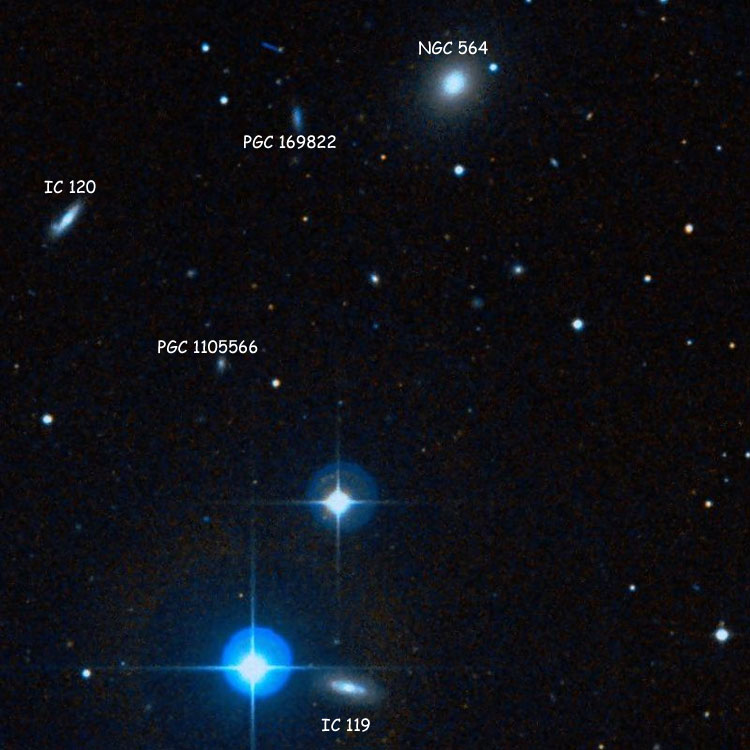
IC 120 (= PGC 5484)
Discovered (Dec 3, 1891) by Stephane Javelle
A 14th magnitude spiral galaxy (type S?) in Cetus (RA 01 28 13.0, Dec -01 54 56)
Per Dreyer, IC 120 (Javelle 60, 1860 RA 01 21 05, NPD 92 38.5) is "faint, small, diffuse". The position precesses to within 0.1 arcmin of the correct position, so the identification is certain. Listed as a member of Abell 194. Based on recessional velocity of 4805 km/sec, about 215 million light years away, in good agreement with a redshift-independent distance estimate of 235 million light years. Given that and apparent size of 0.8 by 0.2 arcmin, about 50 thousand light years across.
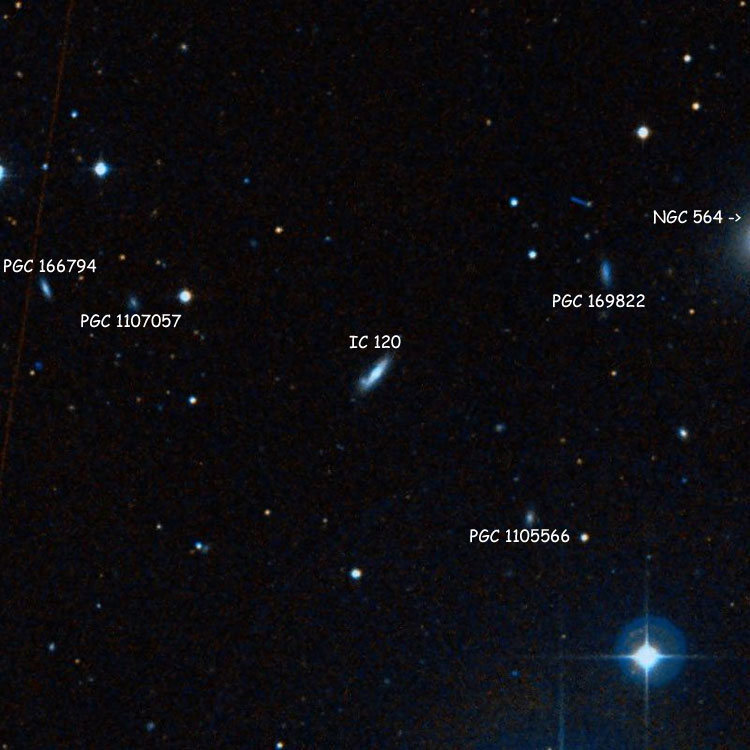
Above, a 12 arcmin wide DSS image centered on IC 120; also see the bottom image for IC 119
Below, a 1 arcmin wide DSS image of the galaxy
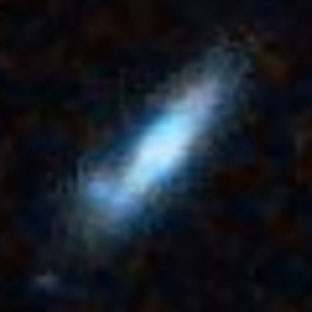
"PGC 6721719"
Not an IC object but listed here as an apparent companion of IC 120
A magnitude 17(?) galaxy (type unknown) in Cetus (RA 01 28 13.8, Dec -01 55 04)
Physical Information: LEDA recognizes its SIMBAD designation (LAMOST J012813.79-015503.6) as PGC 6721719, but a search of LEDA for that designation returns no result, hence the PGC designation being in quotes. LEDA lists a 3K Vr of 5765 km/sec.
That means it is almost certainly a background galaxy, and not actually associated with IC 120
IC 121 (= PGC 5492)
Discovered (Jan 6, 1894) by Stephane Javelle
A 14th magnitude spiral galaxy (type Sbc) in Cetus (RA 01 28 21.8, Dec +02 30 47)
Per Dreyer, IC 121 (Javelle 528, 1860 RA 01 21 08, NPD 88 11.6) is "faint, small, round, gradually brighter middle". The position precesses to 1.3 arcmin north of the correct position, but there is nothing else in the area, and there appears to be no concern or disagreement about the identificaton, so it is presumably reasonably certain. Based on recessional velocity of 9100 km/sec, about 400 million light years away, in good agreement with redshift-independent distance estimates of 350 to 400 million light years. Given that and apparent size of 1.0 by 0.6 arcmin, about 110 thousand light years across.

Above, a 12 arcmin wide DSS image centered on IC 121
Below, a 1.2 arcmin wide DSS image of the galaxy
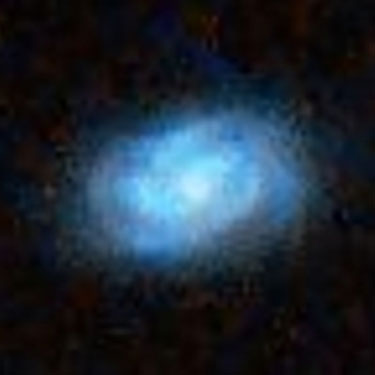
IC 122 (= PGC 919275)
Discovered (Dec 5, 1891) by Stephane Javelle
A 15th magnitude lenticular galaxy (type S0?) in Cetus (RA 01 28 13.2, Dec -14 50 20)
Per Dreyer, IC 122 (Javelle 61, 1860 RA 01 21 22, NPD 105 33.8) is "pretty bright, small, brighter middle". The position precesses to within 0.3 arcmin of the correct position, so the identification is certain. Apparent size 0.6 by 0.3 arcmin; nothing else available. Note: Searching Wikisky for IC 122 puts you close to the galaxy, though not right on it. Searching for PGC 919275 drops the leading 9, and shows PGC 19275 (a very common Wikisky error).
Above, a 12 arcmin wide DSS image centered on IC 122
Below, a 1 arcmin wide DSS image of the galaxy

IC 123 (= PGC 5524)
Discovered (Jan 6, 1894) by Stephane Javelle
A 14th magnitude lenticular galaxy (type SAB(r)0/a?) in Cetus (RA 01 28 51.5, Dec +02 26 47)
Per Dreyer, IC 123 (Javelle 529, 1860 RA 01 21 38, NPD 88 15.7) is "faint, small, round, suddenly brighter middle". The position precesses to an arcmin north-northeast of the correct position, but there is nothing else in the region which could be the object Javelle saw, and no one seems to doubt the correctness of the identification. A Seyfert galaxy (type Sy2). Based on recessional velocity of 9180 km/sec, about 400 million light years away. Given that and apparent size of 0.4 by 0.3 arcmin, about 50 thousand light years across.

Above, a 12 arcmin wide DSS image centered on IC 123
Below, a 1 arcmin wide DSS image of the galaxy

IC 124
Recorded (Dec 3, 1891) by Stephane Javelle
A 15th magnitude star in Cetus (RA 01 29 09.1, Dec -01 56 13)
Per Dreyer, IC 124 (Javelle 62, 1860 RA 01 22 02, NPD 92 39.6) is "very faint, very small, diffuse". The position precesses to within 0.1 arcmin of the star which everyone agrees must be what Javelle observed. Note: A Wikisky search for IC 124 centers on the region between the 15th magnitude star and an 11th magnitude star to its east. The coordinates have to be entered to show the correct object.

Above, a 12 arcmin wide DSS image centered on the star identified as IC 124
IC 125 (= PGC 5560)
Discovered (Jan 5, 1892) by Stephane Javelle
A 15th magnitude lenticular galaxy (type E/S0?) in Cetus (RA 01 29 18.3, Dec -13 16 47)
Per Dreyer, IC 125 (Javelle 63, 1860 RA 01 22 25, NPD 104 00.1) is "very faint, very small, round, a little brighter middle". The position precesses to within 0.3 arcmin of the correct position, so the identification is certain. Apparent size 0.4 by 0.4 arcmin; nothing else available.

Below, a 12 arcmin wide region centered on the galaxy; the star at upper left is magnitude 7.2 HD 9118
Below, a 1 arcmin wide DSS image of the galaxy
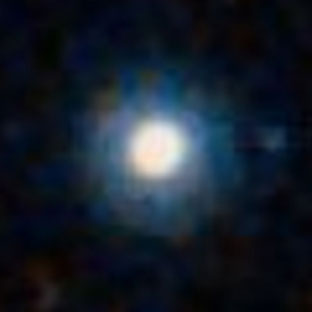
IC 126 (= PGC 5577)
Discovered (Jan 6, 1891) by Stephane Javelle
A 14th magnitude lenticular galaxy (type E/S0?) in Cetus (RA 01 29 47.9, Dec -01 59 01)
Per Dreyer, IC 126 (Javelle 64, 1860 RA 01 22 41, NPD 92 42.5) is "extremely faint, stellar, (NGC) 577 to east". The position precesses to exactly the position of the galaxy listed above, and NGC 577 is about 1 minute of time to the east, so the identification is certain. Listed as a member of Abell 194. Based on recessional velocity of 5895 km/sec, about 265 million light years away, in good agreement with redshift-independent distance estimates of 230 to 305 million light years. Given that and apparent size of 1.2 by 1.2 arcmin, about 90 thousand light years across. 
Above, a 12 arcmin wide DSS image centered on IC 126
Below, a 1.5 arcmin wide DSS image of the galaxy

IC 127 (= PGC 5581)
Discovered (Dec 14, 1892) by Stephane Javelle
A 14th magnitude spiral galaxy (type Sb? edge-on) in Cetus (RA 01 29 47.6, Dec -06 58 48)
Per Dreyer, IC 127 (Javelle 530, 1860 RA 01 22 46, NPD 97 42.5) is "faint, pretty small, diffuse, 11.5 magnitude star close". The position precesses to within 0.2 arcmin of the correct position, and there is an 11th magnitude star overlapping the galaxy's image, so the identification is certain. Based on recessional velocity of 1995 km/sec, about 90 million light years away. Given that and apparent size of 1.8 by 0.5 arcmin, about 45 thousand light years across.
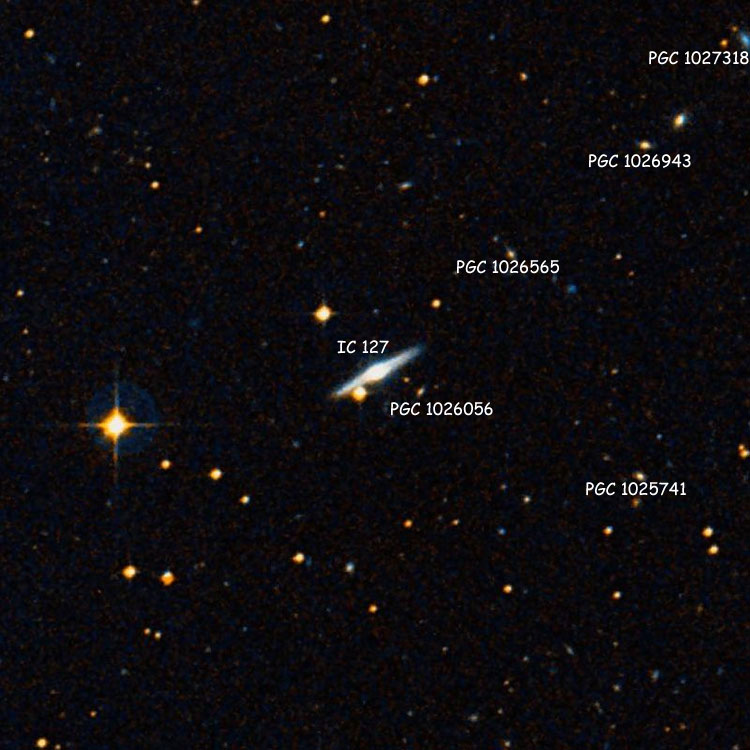
Above, a 12 arcmin wide DSS image centered on IC 127
Below, a 2 arcmin wide DSS image of the galaxy

IC 128 (= PGC 5659)
Discovered (Jan 3, 1891) by Stephane Javelle
A 15th magnitude spiral galaxy (type SBc pec?) in Cetus (RA 01 31 23.8, Dec -12 37 28)
Per Dreyer, IC 128 (Javelle 65, 1860 RA 01 24 30, NPD 103 20.9) is "faint, round, small, nucleus". The position precesses to within 0.1 arcmin of the correct position, so the identification is certain. Based on recessional velocity of 5270 km/sec, about 235 million light years away (another velocity measurement of 5745 km/sec would correspond to 255 million light years). Given that and apparent size of 0.8 by 0.6 arcmin, the main galaxy is about 50 thousand light years across; but with the faint extension to the south and bright arm to the north, the overall extent is closer to 65 thousand light years. IC 128 may be gravitationally bound to IC 129, which would help explain the odd appearance of IC 128, and the complex structure of IC 129. 
Above, a 12 arcmin wide DSS image centered on IC 128, also showing IC 129
Below, a 1.2 DSS image of the galaxy

IC 129 (= PGC 5675)
Discovered (Jan 3, 1891) by Stephane Javelle
A 14th magnitude spiral galaxy (type (R)SAB(rs)0?) in Cetus (RA 01 31 31.2, Dec -12 39 15)
Per Dreyer, IC 129 (Javelle 66, 1860 RA 01 24 37, NPD 103 22.7) is "faint, pretty large, round, diffuse". The position precesses to within 0.1 arcmin of the correct position, so the identification is certain. Based on recessional velocity of 5285 km/sec, about 235 million light years away. Given that and apparent size of 1.3 by 0.9 arcmin, about 90 thousand light years across. IC 129 may be gravitationally bound to IC 128, which would help explain the odd appearance of IC 128, and the complex structure of IC 129. 
Above, a 1.5 arcmin wide DSS image of IC 129; see IC 128 for a wide-field view
IC 130 (= PGC 5671)
Discovered (Sep 2, 1892) by Stephane Javelle
A 14th magnitude spiral galaxy (type (R)Sa pec) in Cetus (RA 01 31 28.7, Dec -15 35 30)
Per Dreyer, IC 130 (Javelle 67, 1860 RA 01 24 38, NPD 106 18.8) is "very faint, small, diffuse". The position precesses to within 0.1 arcmin of the correct position, so the identification is certain. Based on recessional velocity of 13225 km/sec, about 600 million light years away. Given that and apparent size of 0.4 by 0.4 arcmin, about 70 thousand light years across.
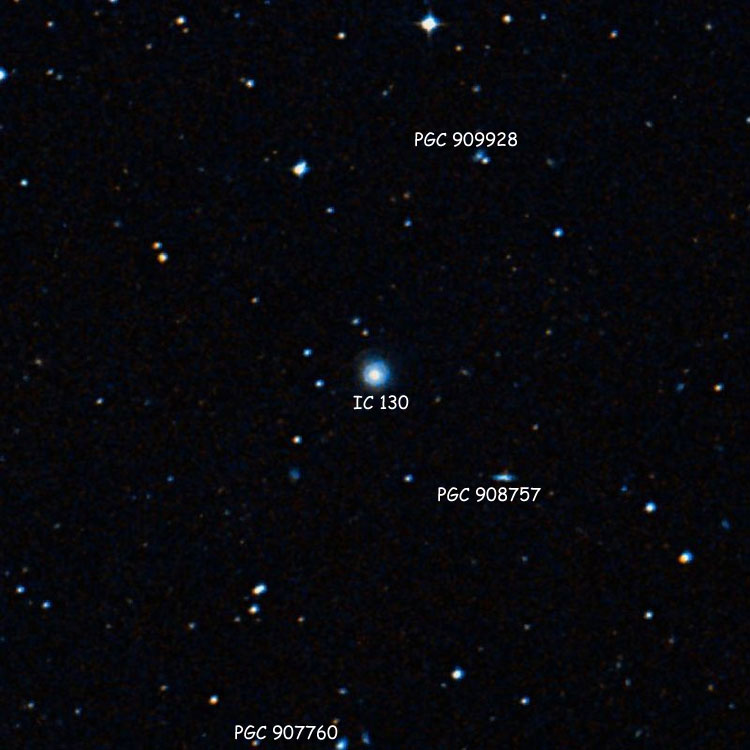
Above, a 12 arcmin wide DSS image centered on IC 130
Below, a 1 arcmin wide DSS image of the galaxy

Finding Chart for IC / NGC Objects in M33, the Triangulum Galaxy
11 of the 13 IC objects from IC 131 to IC 143 (and 4 NGC objects) are located in M33 (= NGC 598), the Triangulum Galaxy. In the images immediately below, which serve as finding charts and wide-field views for the regions surrounding these objects, IC objects are indicated by their numbers, and NGC objects by their numbers preceded by an N (e.g., N604). 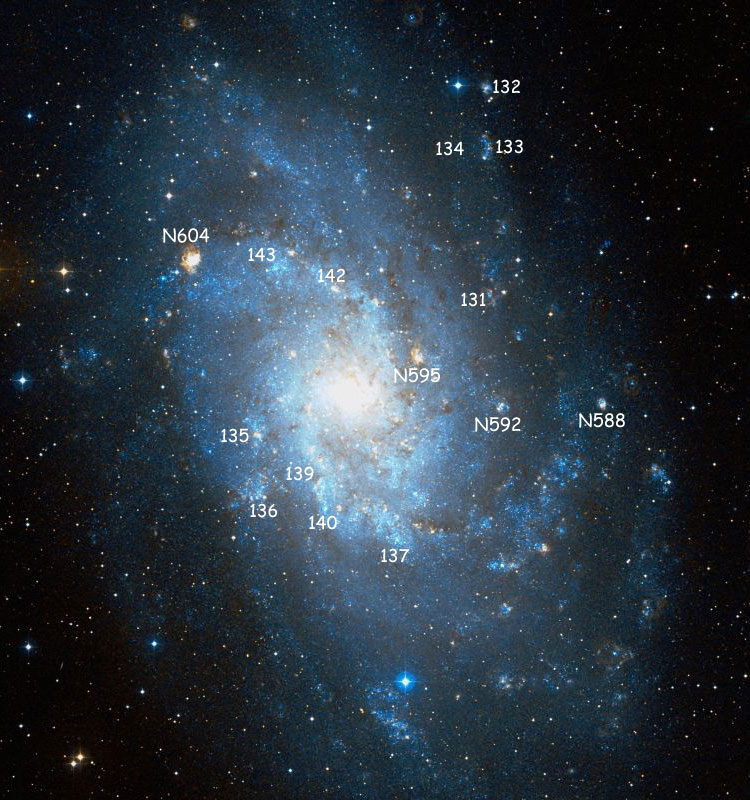
Above, a 42 arcmin wide by 45 arcmin high DSS image of and finding chart for M33
Below, a 15 arcmin wide DSS image of the northwestern part of the galaxy

Below, a 12 arcmin wide DSS image of the southeastern part of the galaxy

IC 131 (in M33, the Triangulum Galaxy)
Discovered (Oct 28, 1889) by Guillaume Bigourdan
A 14th magnitude emission nebula and star clouds in Triangulum (RA 01 33 14.4, Dec +30 44 53)
Northeastern star cloud lies at RA 01 33 15.0, Dec +30 45 09
Southwestern star cloud lies at RA 01 33 13.8, Dec +30 44 37
Per Dreyer, IC 131 (Bigourdan 122, 1860 RA 01 25 22, NPD 59 58) is "very faint, close to magnitude 13.5 star". The position precesses to within 0.2 arcmin of the correct position, so the identification is certain. A part of M33, the Triangulum Galaxy (a member of the Local Group). Per Corwin, IC 131 is often misidentified as the brighter compact HII region just to the west (to the right, in the image below) of the actual nebulosity observed by Bigourdan. However, Bigourdan's measurements and description clearly point at the star clouds labeled as IC 131 in the image, and the brighter HII region is undoubtedly his "13.5 magnitude star", not IC 131. The central nebulosity and star cloud cover about 0.3 by 0.25 arcmin, which corresponds to about 250 light years at the 3 million light year distance of the Triangulum Galaxy. Surrounding star clouds cover perhaps twice that area. 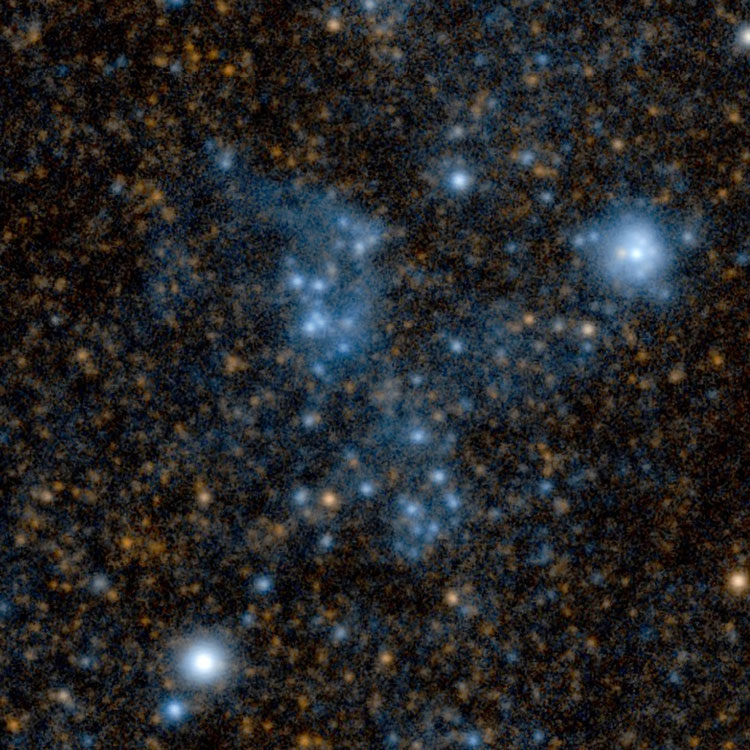
Above, a 2 arcmin wide PanSTARRS image centered on IC 131; see the finding charts above for a wide-field view
IC 132 (in M33, the Triangulum Galaxy)
Discovered (Oct 28, 1889) by Guillaume Bigourdan
A 14th magnitude emission nebula and star cloud in Triangulum (RA 01 33 15.8, Dec +30 56 45)
Per Dreyer, IC 132 (Bigourdan 123, 1860 RA 01 25 23, NPD 59 47) is "very faint, double star close". The position precesses to within 0.5 arcmin of the correct position, and the nearby double star (both 13th magnitude stars) confirms the identification. A part of M33, the Triangulum Galaxy (a member of the Local Group). The Triangulum Galaxy is about 3 million light years away, so the apparent size of IC 132 (about 0.8 by 0.6 arcmin) suggests a physical extent of about 700 light years.

Above, a 1.2 arcmin wide DSS image of IC 132; see the finding charts above for a wide-field view
IC 133 (in M33, the Triangulum Galaxy)
Discovered (Oct 28, 1889) by Guillaume Bigourdan
A 14th magnitude emission nebula and open cluster in Triangulum (RA 01 33 15.6, Dec +30 53 09)
Per Dreyer, IC 133 (Bigourdan 124, 1860 RA 01 25 24, NPD 59 50) is "very faint, small, a very little brighter on south, diffuse". The position precesses to within 0.2 arcmin of the correct position, so the identification is certain. A part of M33, the Triangulum Galaxy (a member of the Local Group). The Triangulum Galaxy is about 3 million light years away, so the apparent size of IC 133 (about 1.5 by 0.7 arcmin, counting the star clouds extending to the north and south) suggests a physical size of about 1300 light years.

Above, a 1.5 arcmin wide DSS image of IC 133; see the finding charts above for a wide-field view
IC 134 (star superimposed on M33, the Triangulum Galaxy)
Recorded (Oct 28, 1889) by Guillaume Bigourdan
A 16th magnitude star in Triangulum (RA 01 33 25.0, Dec +30 54 02)
Per Dreyer, IC 134 (Bigourdan 125, 1860 RA 01 25 33, NPD 59 50) is "very faint, suspected, 9th magnitude star 3 arcmin to north". The position precesses to 0.8 arcmin south of the correct position, but the 9th magnitude star confirms the identification as a foreground star superimposed on the northern side of M33, the Triangulum Galaxy (a member of the Local Group).

Above, a 6 arcmin wide DSS image centered on IC 134; see the finding charts above, for a wide-field view
IC 135 (in M33, the Triangulum Galaxy)
Discovered (Oct 28, 1889) by Guillaume Bigourdan
A 14th magnitude emission nebula in Triangulum (RA 01 34 15.9, Dec +30 37 12)
Corwin lists an eastern portion at RA 01 34 16.3, Dec +30 37 12, and a western portion at RA 01 34 15.4, Dec +30 37 12
Per Dreyer, IC 135 (Bigourdan 126, 1860 RA 01 25 33, NPD 60 18) is "very faint". The position precesses to 01 33 24.5, +30 25 15, which is well to the southwest of the correct position. However, Corwin states that Bigourdan apparently made an error in the position of the comparison star he used for several objects in M33 (namely IC 135, 136, 139 and 140), stating it to be 8 arcmin south and 31 seconds of time west of the nucleus of the galaxy, while (what Corwin thinks is) the star is actually 8 arcmin south and 31 seconds of time east of the nucleus (the star he suggests is apparently the 12th magnitude star 3 arcmin southeast of IC 136, which see). If that is correct, the 1860 RA should be changed to 01 26 35, and the precessed position would be 01 34 27.0, +30 25 11. This is 11s east and 12' south of the correct position, so though closer, it is hard to say that the current position or identification is in any way confirmed. Despite that, the general opinion (Steinicke, Corwin, Leda and NED) seems to be that the specified position is correct; so there must be something I'm missing. (THEREFORE, NOTED AS STILL WORKING HERE) A part of M33, the Triangulum Galaxy (a member of the Local Group). 
Above, a 1.5 arcmin wide DSS image centered on IC 135; see the finding charts above for a wide-field view
IC 136 ( in M33, the Triangulum Galaxy)
Discovered (Oct 28, 1889) by Guillaume Bigourdan
A 15th magnitude open cluster in Triangulum (RA 01 34 15.7, Dec +30 33 42)
Corwin lists an eastern portion at RA 01 34 17.4, Dec +03 33 39,
a middle one at RA 01 34 15.9, Dec +30 33 43,
and a western at RA 01 34 13.9, Dec +30 33 43
Per Dreyer, IC 136 (Bigourdan 127, 1860 RA 01 25 34, NPD 60 15) is "extremely faint, difficult, 10th magnitude star 3 arcmin to northwest". An IC2 correction adds "Not seen on Roberts' plates of M33". The position precesses to 01 33 25.6, +30 28 15, which is 48s west and 5' 25" south of the correct position (which is presumably why the object was not seen on Roberts' plates). As for IC 135, Corwin suggests an error in the comparison star, but the simple error suggested wouldn't take care of the problem. Also, the only star near the supposed position is a 12th magnitude star 3 arcmin southeast; so again, the identification, though generally agreed to be correct, seems to be of uncertain accuracy. THEREFORE, STILL WORKING HERE, AS WELL. A part of M33, the Triangulum Galaxy (a member of the Local Group).

Above, a 2.4 arcmin wide PanSTARRS image centered on IC 136; see the finding charts above for a wide-field view
IC 137 (in M33, the Triangulum Galaxy)
Discovered (Oct 28, 1889) by Guillaume Bigourdan
A 14th magnitude open cluster in Triangulum (RA 01 33 39.0, Dec +30 31 21)
Per Dreyer, IC 137 (Bigourdan 128, 1860 RA 01 25 44, NPD 60 13) is "very faint, pretty large, diffuse". A part of M33, the Triangulum Galaxy (a member of the Local Group). The position precesses to 01 33 35.7, +30 30 15, 3.3s west and 68" south of the 'correct' position, though close enough to the "star cloud" that it is seems a reasonable guess for the correct object. STILL WORKING HERE TOO (sigh)

Above, a 2.4 arcmin wide DSS image centered on IC 137; see the finding charts above for a wide-field view
IC 138 (= PGC 5771)
Discovered (Sep 27, 1867) by Aaron Skinner
A 14th magnitude spiral galaxy (type SAB(rs)c) in Cetus (RA 01 33 02.0, Dec -00 41 23)
Historical Identification: Per Dreyer, IC 138 (Safford 95, 1860 RA 01 25 36, NPD 91 23.9) was listed with "no description". The position precesses to more than 4 arcmin west of the correct position, but there doesn't seem to be any disagreement about the identification, perhaps because there is nothing else in the area which could have been seen with the equipment of the time.
Discovery Notes: Skinner was one of Truman Safford's assistants, and as usual in such cases, the author of the published report received credit, instead of the actual discoverer.
Physical Information: Listed as a member of Abell 194. Based on recessional velocity of 4635 km/sec, about 200 million light years away. Given that and apparent size of 1.-0 by 0.7 arcmin (from the images below), about 70 thousand light years across.

Above, a 12 arcmin wide SDSS image centered on IC 138; the box at the right shows Dreyer's position
Below, a 1.2 arcmin wide SDSS image of the galaxy

IC 139 (in M33, the Triangulum Galaxy)
Discovered (Oct 28, 1889) by Guillaume Bigourdan
A 14th magnitude open cluster in Triangulum (RA 01 33 59.3, Dec +30 34 33)
Per Dreyer, IC 139 (Bigourdan 129, 1860 RA 01 25 50, NPD 60 15) is "very faint, very diffuse, a very little brighter middle". A part of M33, the Triangulum Galaxy (a member of the Local Group).

Above, a 2.4 arcmin wide DSS image centered on IC 139; see the finding charts above for a wide-field view
IC 140 (in M33, the Triangulum Galaxy)
Discovered (Oct 28, 1889) by Guillaume Bigourdan
A 13th magnitude open cluster in Triangulum (RA 01 33 58.0, Dec +30 33 06)
Per Dreyer, IC 140 (Bigourdan 130, 1860 RA 01 25 52, NPD 60 14) is "very faint, diffuse". A part of M33, the Triangulum Galaxy (a member of the Local Group).
Note About "Companion": IC 140 is only the cluster of stars in the center of the image below; but Corwin lists the emission nebula at RA 01 33 54.3, Dec +30 33 10 (to the west, or right side of the cluster in the image below), though it should perhaps be thought of as a neighboring region of interest, rather than a "companion" in the normal use of that word in this catalogue.

Above, a 2.4 arcmin wide DSS image centered on IC 140; see the finding charts above for a wide-field view
IC 141 (= PGC 5765)
Discovered (Dec 5, 1891) by Stephane Javelle
A 14th magnitude spiral galaxy (type SB(rs)c?) in Cetus (RA 01 32 51.7, Dec -14 48 52)
Historical Identification: Per Dreyer, IC 141 (Javelle 68, 1860 RA 01 26 00, NPD 105 32.1) is "pretty bright, small, round, nucleus 11.5 magnitude excentr". (The term "excentr" is not listed in Dreyer's table of abbreviations, but probably means "eccentric", or offset from the center of the nebula, and is undoubtedly due to the star adjacent to the nucleus.) The position precesses to within 0.2 arcmin of the position of the galaxy listed above, so the identification is certain.
Physical Information: Based on a recessional velocity of 11385 km/sec, about 500 million light years away. Given that and apparent size of 1.7 by 1.2 arcmin (from the images below), about 180 thousand light years across.

Above, a 12 arcmin wide DSS image centered on IC 141
Below, a 2.2 arcmin wide PanSTARRS image of the galaxy; the star just right (west) of the nucleus is of course in our galaxy

IC 142 (in M33, the Triangulum Galaxy)
Discovered (Oct 28, 1889) by Guillaume Bigourdan
A 14th magnitude star cluster in Triangulum (RA 01 33 55.7, Dec +30 45 27)
Per Dreyer, IC 142 (Bigourdan 131, 1860 RA 01 26 07, NPD 59 58) is "very faint, stellar, or 13th magnitude star involved". A part of M33, the Triangulum Galaxy (a member of the Local Group).

Above, a 2.4 arcmin wide DSS image centered on IC 142; see the finding charts above for a wide-field view
IC 143 (in M33, the Triangulum Galaxy)
Discovered (Oct 28, 1889) by Guillaume Bigourdan
A 14th magnitude emission nebula in Triangulum (RA 01 34 11.1, Dec +30 46 37)
Per Dreyer, IC 143 (Bigourdan 132, 1860 RA 01 26 18, NPD 59 57) is "very faint, small, diffuse, 13th magnitude star 0.6 arcmin to east". A part of M33, the Triangulum Galaxy (a member of the Local Group).
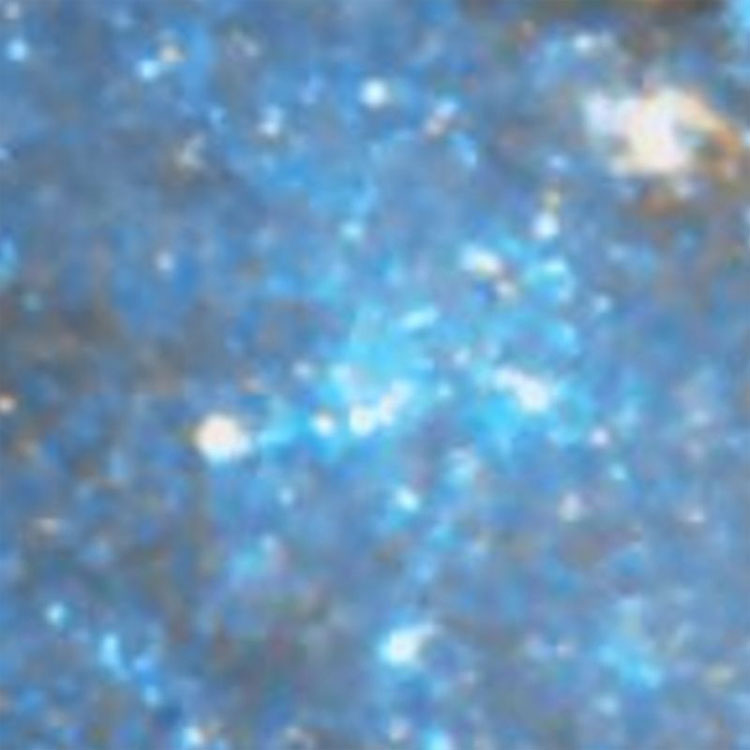
Above, a 2.4 arcmin wide DSS image centered on IC 143; see the finding charts above for a wide-field view
IC 144 (= PGC 6027)
Discovered (Jan 2, 1892) by Stephane Javelle
A 15th magnitude galaxy (type C?) in Cetus (RA 01 37 40.8, Dec -13 18 53)
Per Dreyer, IC 144 (Javelle 69, 1860 RA 01 30 49, NPD 104 01.8) is "extremely faint, extremely small, stellar". The position precesses to within 0.1 arcmin of the correct position, so the identification is certain.
IC 145 (= PGC 6084)
Discovered (Dec 12, 1893) by Stephane Javelle
A 15th magnitude spiral galaxy (type S?) in Cetus (RA 01 38 38.5, Dec +00 44 29)
Per Dreyer, IC 145 (Javelle 531, 1860 RA 01 31 27, NPD 89 58.2) is "faint, small, diffuse". The position precesses to within 0.2 arcmin of the correct position, so the identification is certain.
IC 146 (= NGC 648 = PGC 6083 = PGC 144217 = PGC 876776)
Discovered (1886) by Francis Leavenworth (and later listed as NGC 648)
Discovered (Sep 30, 1892) by Stephane Javelle (1-70) (and later listed as IC 146)
A 14th magnitude lenticular galaxy (type E/S0?) in Cetus (RA 01 38 39.8, Dec -17 49 52)
Per Dreyer, IC 146 (Javelle 70, 1860 RA 01 31 54, NPD 108 32.4) is "faint, very small, round, a little brighter middle". Javelle's precessed position is more than 2 arcmin east of the galaxy, but there is nothing else in the region, so there is no doubt of the identification. Per Corwin, the double listing was caused by Leavenworth's position being two minutes off, so Javelle had no reason to think he was observing the same object. Howe noticed the error in Leavenworth's position after, and Dreyer published the correction for NGC 648 in his revised catalog; but no one noticed that this proved the two objects the same until much later.
IC 147 (= PGC 6164)
Discovered (Dec 7, 1893) by Stephane Javelle
A 15th magnitude spiral galaxy (type S(rs)cd?) in Cetus (RA 01 39 59.7, Dec -14 51 46)
Per Dreyer, IC 147 (Javelle 532, 1860 RA 01 33 10, NPD 105 33.8) is "faint, very small, round, very faint star close". The position precesses to within 0.7 arcmin of the correct position, and there is a faint object nearby (though actually another galaxy), so the identification is certain. Based on recessional velocity of 15055 km/sec, about 670 million light years away. Given that and apparent size of about 0.75 by 0.5 arcmin (from the images below), about 155 thousand light years across.
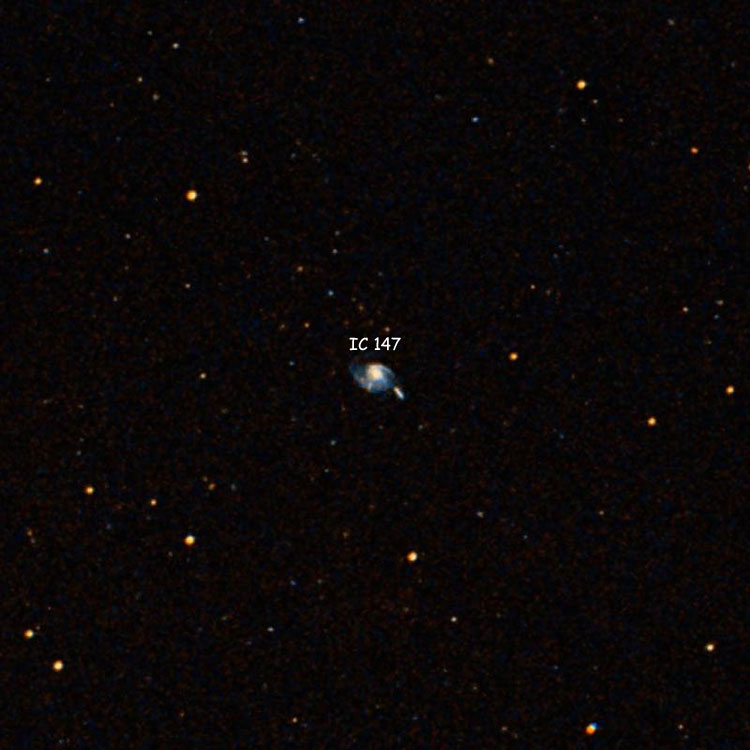
Above, a 12 arcmin wide DSS image centered on IC 147
Below, a 1.2 arcmin wide PanSTARRS image, also showing PGC 918901 and 2MASS 01400011-1451577

PGC 918901
Not an IC object but listed here as an apparent companion of IC 147
A magnitude 17(?) galaxy (type ?) in Cetus (RA 01 39 58.3, Dec -14 52 03)
Physical Information: Apparent size 0.35 by 0.15 arcmin; nothing else available, so whether it is in any way connected to IC 147 is unknown.
Classification Note: All that can be said is that this is an edge-on galaxy; whether it is a lenticular or spiral galaxy cannot be determined from the available images. Based on its PanSTARRS image, its peculiar southwestern "extension" is probably due to a foreground star (in our own galaxy) superimposed on the galaxy. Apparent size 0.18 by 0.07 arcmin (from the image of IC 147)
Since PGC 918901 is in nearly the same direction as IC 147, see that entry for an image
2MASS 01400011-1451577
Not an IC object but listed here as an apparent companion of IC 147
A ? magnitude galaxy (type ?) in Cetus (RA 01 40 00.1, Dec -14 51 56)
Physical Information: Absolutely nothing appears to be available for this galaxy; but since it appears to be behind the spiral arm of IC 147, it is almost certainly a background galaxy, and not an actual "companion" of the IC object. Apparent size 0.16 by 0.04 arcmin (from the image of IC 147)
Since 2MASS 01400011-1451577 is in nearly the same direction as IC 147, see that galaxy for an image
IC 148
(= PGC 6292 = UGC 1195 = CGCG 437-010 = MCG +02-05-011)
Discovered (Sep 30, 1890) by Lewis Swift
A 13th magnitude spiral galaxy (type Irr?) in Pisces (RA 01 42 27.0, Dec +13 58 37)
Per Dreyer, IC 148 (Swift list X (#6), 1860 RA 01 34 54, NPD 77 03.6) is "most extremely faint, pretty small, very difficult, II. 253 to southeast", (WH) II. 253 being NGC 660, which does lie to the southeast of IC 148.
IC 149
(= PGC 6289 = MCG -03-05-015)
Discovered (Dec 7, 1893) by Stephane Javelle
A 14th magnitude spiral galaxy (type S?) in Cetus (RA 01 42 25.4, Dec -16 18 02)
Per Dreyer, IC 149 (Javelle 533, 1860 RA 01 35 36, NPD 107 00.2) is "faint, pretty small, extended east-west, a little brighter middle".
|